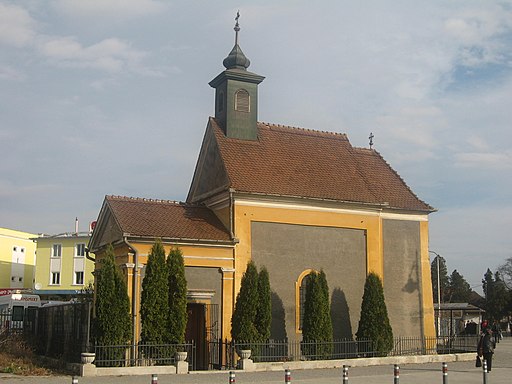Holy Cross Chapel
Address:
Piaţa 1 Decembrie 1918 nr. 2
Historical Hungarian county:
Szeben
GPS coordinates:
45.8002954492, 24.1603276908
History
In 1219, King Andrew II of Hungary, returning from his crusade, ordered a cross to be erected in front of the castle gates of Nagyszeben and a chapel to be built where mass would be celebrated every Friday. The chapel was later joined with the Dominican monastery. In 1417, a stone cross 7.3 metres high, the work of Austrian sculptor Peter Lantregen, was placed above the altar. As the monastery and church stood outside the defensive wall, the Tatars destroyed it and, although it was soon rebuilt, the Dominican monks moved inside the wall with the permission of the town in 1474 and built a new church. The monastery and church were left to the town, and they set up a hospital for lepers in the building. The complex remained intact until 1659. In the meantime, Prince Rákóczi György II of Transylvania launched a war to seize the Polish throne, but his plan failed, and as the Turks did not give their consent to the attack, they put Barcsay Ákos on the throne of Transylvania. Barcsay fled from Rákóczi with his troops of Turks to the town, so Rákóczi attacked Nagyszeben. At this time, the leadership of Nagyszeben demolished the buildings around the town, including the monastery and the chapel, so that they would not serve as cover for the attackers. The cross was buried under the ruins. The siege ended in 1660 and the troops withdrew. And in 1683, when the Turks were defeated at Vienna, the mayor of Nagyszeben ordered the huge cross to be dug up and erected. In 1755, the Chapel of the Cross was built over it.
{"item":"sight","set":{"sightId":1914,"townId":75,"active":1,"name_LO":"","address":"Pia\u0163a 1 Decembrie 1918 nr. 2","mapdata":"1|2683|1361","gps_lat":"45.8002954492","gps_long":"24.1603276908","religion":1,"oldtype":"2","newtype":"2","homepage":"","openinghours":"","muemlekemlink":"","csemadoklink":"","picture":"\u003Ca title=\u0022Cezar Suceveanu, CC BY-SA 3.0 <https:\/\/creativecommons.org\/licenses\/by-sa\/3.0>, via Wikimedia Commons\u0022 href=\u0022https:\/\/commons.wikimedia.org\/wiki\/File:Capela_Sf._Cruce_din_Sibiu.jpg\u0022\u003E\u003Cimg width=\u0022512\u0022 alt=\u0022Capela Sf. Cruce din Sibiu\u0022 src=\u0022https:\/\/upload.wikimedia.org\/wikipedia\/commons\/thumb\/7\/7b\/Capela_Sf._Cruce_din_Sibiu.jpg\/512px-Capela_Sf._Cruce_din_Sibiu.jpg\u0022\u003E\u003C\/a\u003E","picture_ref":"\u003Ca href=\u0022https:\/\/commons.wikimedia.org\/wiki\/File:Capela_Sf._Cruce_din_Sibiu.jpg\u0022\u003ECezar Suceveanu\u003C\/a\u003E, \u003Ca href=\u0022https:\/\/creativecommons.org\/licenses\/by-sa\/3.0\u0022\u003ECC BY-SA 3.0\u003C\/a\u003E, via Wikimedia Commons","name":"Holy Cross Chapel","note":"","history":"In 1219, King Andrew II of Hungary, returning from his crusade, ordered a cross to be erected in front of the castle gates of Nagyszeben and a chapel to be built where mass would be celebrated every Friday. The chapel was later joined with the Dominican monastery. In 1417, a stone cross 7.3 metres high, the work of Austrian sculptor Peter Lantregen, was placed above the altar. As the monastery and church stood outside the defensive wall, the Tatars destroyed it and, although it was soon rebuilt, the Dominican monks moved inside the wall with the permission of the town in 1474 and built a new church. The monastery and church were left to the town, and they set up a hospital for lepers in the building. The complex remained intact until 1659. In the meantime, Prince R\u00e1k\u00f3czi Gy\u00f6rgy II of Transylvania launched a war to seize the Polish throne, but his plan failed, and as the Turks did not give their consent to the attack, they put Barcsay \u00c1kos on the throne of Transylvania. Barcsay fled from R\u00e1k\u00f3czi with his troops of Turks to the town, so R\u00e1k\u00f3czi attacked Nagyszeben. At this time, the leadership of Nagyszeben demolished the buildings around the town, including the monastery and the chapel, so that they would not serve as cover for the attackers. The cross was buried under the ruins. The siege ended in 1660 and the troops withdrew. And in 1683, when the Turks were defeated at Vienna, the mayor of Nagyszeben ordered the huge cross to be dug up and erected. In 1755, the Chapel of the Cross was built over it.\n&\nwelcometoromania.eu: Nagyszeben, Szent Kereszt K\u00e1polna|https:\/\/www.welcometoromania.eu\/Sibiu\/Sibiu_Capela_Sfcruci_m.htm","town":{"townId":75,"name_HU":"Nagyszeben","name_LO":"Sibiu","seolink":"nagyszeben-sibiu","oldcounty":36,"country":4}},"language":"en","region":"romania","regionid":4,"offer":[],"gallery":false,"album":false}

